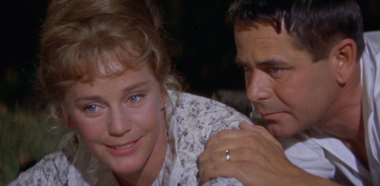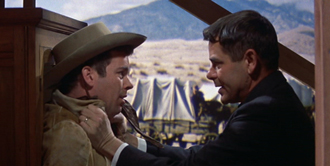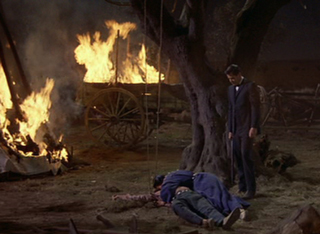
 |
|
|
|
For a non-celebrity director, Anthony Mann had a career with a stellar arc. His rise to success was initiated against the odds when he turned two cheap Eagle-Lion noirs (Raw Deal and T-Men into A-list successes; for the rest of the 1950s it was studio contracts and smart associations that paid off at every step. At MGM he continued to make admired "small" pictures while proving himself a handy man to have around -- his excellent fire sequence in Quo Vadis is an oasis in otherwise static filmmaking. The last couple of years have seen most of Mann's western filmography released on Region 1 DVD. The James Stewart westerns 1 were joined by The Furies and Man of the West, with relatively few holdouts, notably Devil's Doorway. 
1960s Cimarron was not a commercial or a critical success. I remember reading essays and even books lauding Anthony Mann, where the CinemaScope remake of the 1931 Best Picture Oscar winner was barely mentioned. Cimarron comes at the beginning of Anthony Mann's second major career move, from a bankable name director to a maker of enormous Road Show epics. It was the second of two epic stumbles. Star-producer Kirk Douglas fired Mann from the 70mm Spartacus after only a few weeks of filming. Mann made Cimarron at MGM, and ran into a wall of front-office interference. Both the script and location shooting time were cut way back, imparting a stage-bound, back-lot MGM feel to the bulk of the movie. Worse yet, at some point director Charles Walters was brought in to re-shoot some sequences. Anthony Mann couldn't have been happy about this; after fifteen years of relative freedom (interrupted by star interference from Douglas and James Stewart) he'd been allowed to shape his movies as he pleased. Other factors probably figured in, but Cimarron most likely hit a budgetary impasse precipitated by the studio finance crises of the late 1950s. As it was, Mann's good reputation got him his next "gig", the enormous Bronston production El Cid, a huge success. Cimarron's first forty minutes or so are terrific. Yancy Cravat (Glenn Ford) takes his new, city-bred wife Sabra (Maria Schell, fresh from her triumph in Delmer Daves' The Hanging Tree) out west hoping to win a farm in the Great Oklahoma Land Rush. Yancy's stature as the living spirit of The Frontier is established early, and frequently reconfirmed. He's on a first name basis with outlaws like The Cherokee Kid (Russ Tamblyn), intellectual newspaperman Sam Pegler and his wife (Robert Keith & Aline McMahon) and clueless sodbusters Tom and Sarah Wyatt (Arthur O'Connell of Man of the West and Mercedes McCambridge of Giant and Johnny Guitar). The Land Rush has the same problem in the 1931 version of Edna Ferber's multi-generational epic -- the big scene is in act one. Everybody knows what happens to the Titanic, but it and The Alamo at least have the courtesy to serve as foolproof movie climaxes. Mann's version of the Land Rush isn't any bigger, just a little more bloodthirsty -- unlucky participants might find more safety in the middle of the Ben-Hur chariot race. The CinemaScope frame gooses the spectacle factor, aided by some good mattes. Look out for an American flag behaving oddly across the matte lines. A simply great optical printer trick pans across two separate shots of wagons charging the camera, doubling the number of apparent land rushers. 
The rest of Cimarron is problematic. It basically recounts the Yancy Cravat character's inability to truly settle down; he embodies the restless frontier too faithfully. While Sabra establishes civilization in the new town of Osage with a newspaper empire, her husband runs off to oil deals, wars and more land rushes. He builds a legend around himself but never really gets anywhere. Unfortunately, none of this happens on camera. Glenn Ford insists on playing the role as lovable and coy. Cravat more or less exits the movie at midpoint, returning now and then to briefly pose in noble profile close-ups. The '31 original brought Cravat back as a mystery 'raggedy man', reunited with his ever-faithful wife only at the point of dying. In Mann's film Yancy's demise takes place off-screen, with only a hasty montage and a telegram announcing the event. It's as if Cimarron were a five-hour movie, with the important half missing. The half that remains is fairly well done, at least from Sabra's point of view. She grows from a clueless innocent to a wise old woman by suffering an absent husband, business setbacks and all the growing pains of a new territory. Since Yancy was tricked out of his farm claim by his old flame (and "Social Club" owner) Dixie Lee (Anne Baxter), the Cravats remain mostly rootless. The incompetent farmers the Wyatts strike oil and become illiterate rich folk and predatory capitalists. Sabra remains faithful to the mostly missing Yancey, forming life relationships with fellow newsmen and business folk (Harry Morgan, David Opatashu, etc.). A heavy-duty, unsubtle Civil Rights sub-theme runs through Cimarron, diverting its energies. The script steers Mann to rehash elements of George Stevens' Giant, another Edna Ferber original, with the bigotry directed this time at Native Americans. There's nothing wrong with the theme, but it's not particularly compatible with Mann's filmmaking style, which is direct and often violent. We watch while Charles McGraw's unregenerate racist baits an Indian who dares race for land. McGraw wrecks the Indian's wagon. Later, he lynches the man in front of his family. 
Yancey becomes a rather ineffectual hero. He tries to defend the Indian but has to be satisfied with hiring his widow and children as servant-employees. He also can't prevent the school from refusing to teach the Indian child. Fifteen years later Sabra must deal with her own prejudices when her son falls in love with the same Indian child, now a young woman. We don't expect the movie to resolve these problems but it doesn't know how to dramatize them effectively; the Inidans really don't have speaking roles. Mann does create some great images, like the shot of the tiny girl being shoved out of the schoolhouse and sent home. Cravat deals with "social" problems more realistically than did his 1931 predecessor, who shot it out with bad guys and presided over raucous political rallies. The problems the 1960 Yancey confronts have no easy solutions. Cravat must face violence when his old buddy The Cherokee Kid shoots up the town with a "bad apple" gunslinger (Vic Morrow). This subplot aligns closely with the story of Pat Garrett and Billy the Kid and provides an action scene that Mann handles extremely well.. But once Morrow and McGraw are dispatched, Cimarron hasn't much more to offer in the way of action. The film's strongest appeal is likely to be as a women's western. While Glenn Ford runs on automatic pilot, Maria Schell delivers all of Cimarron's dramatic highlights. Sabra and Sarah Wyatt take center stage for a boisterous childbirth scene. A couple of scenes with Dixie Lee make us wish that Anne Baxter's character was more substantial, or eliminated altogether. On one of Yancey's rare visits back home, he and Sabra go to Washington. Sabra is delighted when her husband is offered a cushy political appointment in the new Oklahoma Territory, and enraged when he turns it down: he doesn't tell her that the appointment is from a group of corrupt congressmen. The film's good scenes tend to be marooned, lost in the blah MGM house style -- terrible flat lighting for everything -- and lumpy editorial continuity. Cimarron plays as if someone went through the script, arbitrarily eliminating scenes, and patching up the gaps with new material directed by Charles Walters. 
I still find it a fascinating movie, and one to examine carefully. When Anthony Mann has a trim script or an epic with a strong through line, he almost always comes through. The compromised Cimarron is much better than its reputation would suggest. Warners' DVD of the 1960 Cimarron is a fine enhanced transfer from an element with good color. When the director and cameraman Robert Surtees show off their CinemaScope framing, the picture looks terrific. Sound is clear as well; the choral theme behind the titles seems a warm-up for How The West Was Won. The disc is offered at a budget price, and also as part of the boxed Warner Home Video Western Classics Collection with Escape from Fort Bravo, Many Rivers to Cross, The Law and Jake Wade, Saddle the Wind and The Stalking Moon. No extras are included.
On a scale of Excellent, Good, Fair, and Poor,
Cimarron (1960) rates:
Footnotes:
1. Winchester '73, The Naked Spur, Bend of the River, The Far Country, and The Man from Laramie.
Reviews on the Savant main site have additional credits information and are often updated and annotated with reader input and graphics. Also, don't forget the 2008 Savant Wish List. T'was Ever Thus.
Review Staff | About DVD Talk | Newsletter Subscribe | Join DVD Talk Forum |
| ||||||||||||||||||